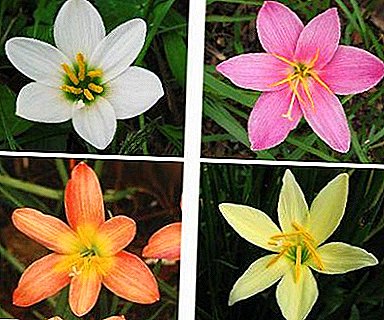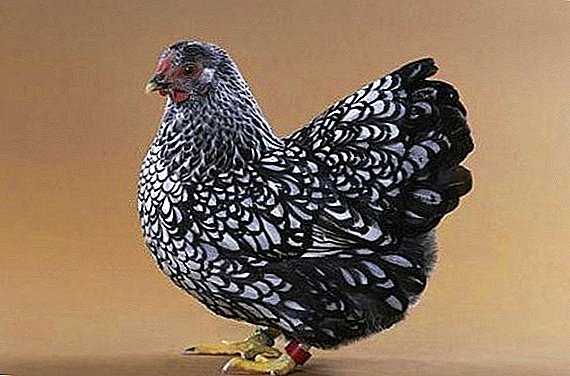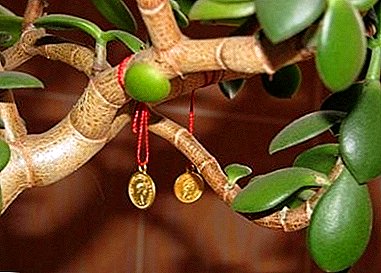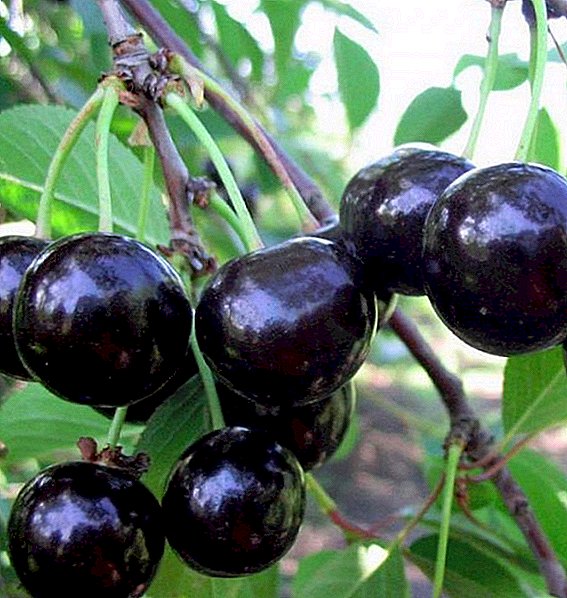
"Zephyranthes" (Upstart) refers to perennial small-herbaceous plants Amaryllis family.
In natural conditions, the place of its growth is South and Central America (humid tropics and subtropics).
The official name of "Zephyranthes" is translated as "flower of the west wind".
Apparently, this is due to the fact that in the wild nature it emerges from the ground with the onset of the rainy season, when the westerly wind begins to blow (Zephyr).
Another title "Upstart" he got for being amazing grows quickly and blooms. From its appearance until the beginning of flowering only a few days pass. And how is another flower called “Upstart”? There are many options: “Rain” or “Water Lily”, “Rain Flower” or “Home Daffodil”.
What are the features of the flower "Zephyranthes" photo, care at home for a plant - all this and not only you will find in this article.
general description
 Plant "upstart" has small bulbs (up to 3.5 cm in diameter) rounded or ovoid, their neck can be either long or short.
Plant "upstart" has small bulbs (up to 3.5 cm in diameter) rounded or ovoid, their neck can be either long or short.
Linear or belt-like dark green foliage reaches forty centimeters in length and one in width.
Tubular peduncles grow to thirty centimeters. Star-shaped flowers (about 8 cm in diameter) resemble crocuses.
They can be very different colors and bloom in parallel with the appearance of the leaves. Flowering may occur at any time of the year.
In countries where the upstart flower is widespread in the wild, as well as in China, its widespread applied in their practice traditional healers. They use it to treat abscesses, wounds, burns, diabetes, hepatitis, respiratory diseases, liver and kidneys.
Why it is impossible to keep the upstart flower at home and, as is the case with other plants, to self-medicate? The fact is that plant bulbs contain a number of toxic substances therefore, precautions must be taken to avoid serious consequences.
According to folk beliefs, “Zephyrantes” helps to preserve the love, tenderness and understanding between the spouses for many years. During the period of growth and flowering, the plant has a powerful energy, which eliminates shyness, stiffness and stiffness. People who grow Zefirantes become more relaxed and sociable.
Your attention flower "Upstart" - photos of the plant:




Species and their bloom
In the wild conditions of growth, there are about forty species of "Zephyranthes".
Few of them are grown as room cultures:
- to belotsvetkovymi The varieties include Zetafirantes Atamas, blooming in early spring, and Zefirantes white (snow-white), which blooms in July and ends in October;
- from yellow flowers species grown at home "Zefirantes" golden. Flowers appear in December or January;
- red flowers represented by "Zephyranthes" large-flowered (keeled), blooming from early to late autumn;
- of two colors The species of interest is Zephyranthes multicolored (multicolored habrantus), which usually blooms in January.




As can be seen, the onset of flowering depends on the type of plant. Placing on the windowsill several varieties of "Zephyranthes", you can admire their flowering all year round.
Home care
“Zefirantes” does not require special care at home, and therefore gained popularity among fans of indoor plants for its unusual beauty and unpretentiousness.
The only significant difficulty in caring for him is that in different types of flowering and dormant period occur at different times of the year.
For him it is impossible to make standard recommendations for the content, for each specific plant should be an individual approach in accordance with its annual cycle. Therefore, it is important to learn more about the flower "Upstart" and care at home for him.
Lighting
Zefirantesu very good lighting is required, therefore, it is best to place it in the southern part of the room, creating additional shading in particularly hot sunny days. Also suitable sills western and eastern windows.
Air temperature and humidity
"Zephyranthes" - it is a heat-loving plant, in this regard, when it is in the stage of growth and flowering, it must be maintained at a temperature of from twenty to twenty-five degrees. With the beginning of the rest period, it is desirable to reduce it to twelve degrees.
Watering and feeding
"Zephyranthes", as a native of tropical forests, should always be in wet soil.
Wherein do not allow overflows, which provoke rotting bulbs.
Therefore, the top layer of soil should be slightly dry between watering.
IMPORTANT! If the soil is too dry, then the plant will leave for a period of rest, and after several subsequent waterings will come out of “hibernation”. This violates its natural growth cycle and adversely affects its condition.
 After flowering "Zephyranthes" begins preparing for a period of rest, at this time you need reduce watering and moisturize it no more than twice a month.
After flowering "Zephyranthes" begins preparing for a period of rest, at this time you need reduce watering and moisturize it no more than twice a month.
This is required in order not to drop all the foliage, in the event that wintering takes place in normal room conditions at high temperatures.
Feeding "Zephyranthes" carried out twice a month using any complex mineral fertilizer. It should start at the end of the rest period and stop with the completion of flowering.
Soil and planting pot
For landing "Zephyranthes" light, loose and nutritious soil is required. To do this, you can purchase a universal substrate for flowering plants. If the soil mixture is prepared independently, you can mix equal quantities of turf, leaf soil, humus and coarse sand.
Pot for "Zephyranthes" should choose low, but wide, so that several bulbs could fit in it, and there was room for their growth and the formation of children.
Three to five bulbs planted in one container, create a high decorative effect, especially during flowering. If you prefer the option of planting a single instance, then the diameter of the pot should be only a few centimeters larger than the bulb itself.
Transplant and pruning
 Transplant "Zephyranthes" should be carried out shortly before the end of the rest period.
Transplant "Zephyranthes" should be carried out shortly before the end of the rest period.
To do this, you need to prepare a suitable container with holes at the bottom, a good drainage layer and properly selected soil.
The bulbs must be removed from the old pot, inspect the roots and remove the rotted, if they are.
Place the slices need to sprinkle with powdered activated carbon.
Choosing large bulbs, you need to bury them in the soil, leaving the surface of the neck. First it is impossible to water the plants for several days after transplantation
Zefirantes does not require any special trimming. It is only necessary in the process of growth and flowering to remove dead leaves and flowering buds. This will contribute to the preservation of high ornamental plants.
Breeding
Reproduction "Zephyranthes", like all bulbous plants, the easiest way to conduct using daughter bulbs (kids). You can also do this with seeds.
Seed
Growing "Zephyranthes" from the seeds is quite possible, but due to the laboriousness of the process in room dilution is rarely used. In addition, the flowering of such plants should wait three to six years.
If the desire to experiment is still great, then you can try. To do this, it is best to use seeds obtained independently by artificial pollination.
Sowing need to produce immediately after ripening of the fruit box and the collection of planting material, as the percentage of germination decreases very quickly.
 For planting it is necessary to take a wide bowl, fill it with drainage and soil, which must be well moistened.
For planting it is necessary to take a wide bowl, fill it with drainage and soil, which must be well moistened.
Seeds are distributed over the surface of the soil at a distance of two to three centimeters from each other.
Landing covered with foil polyethylene and placed in a room with good lighting and an air temperature of about twenty-two degrees.
Shelter need take ten to fifteen minutes every day to air and moisten crops. Shoots should be expected within a month, after they appear, you need to remove the film. Do not plant too small seedlings, you need to give them a good strength.
Child bulbs (kids)
This breeding method more simple and effective than the previous one. During the year of growth, each bulb can form up to fifteen children. Therefore, during transplantation, they must be carefully separated from the mother plant and used for reproduction.
In the prepared bowl five to ten onions are planted, those that are too small and have a short neck are buried completely in the soil, while those that have a long neck should remain on the surface.
The top layer of soil should be slightly moistened with a spray bottle, and then not watered for several days. In the future, the young "Zephyrantes" is the usual care.
Period of rest and active growth
 The period of rest at "Zephyranthes" comes at a different time It depends on the characteristics of the selected plant species.
The period of rest at "Zephyranthes" comes at a different time It depends on the characteristics of the selected plant species.
Therefore, in relation to him it is impossible to speak specifically about leaving in the spring or leaving in the winter.
How to care for the upstart flower during active growth and flowering and during the rest period?
After graduation flowering at "Zephyranthes" there is a period of peace.
At this time, if possible, it is necessary move to a room with a temperature of about twelve degrees and reduce watering to a minimum if the plant overwinters with foliage. If the leaves fall off or they are pruned, the flowers of Zephyranthes can be stored in the refrigerator without watering it.
IMPORTANT! The temperature of the "Zephyranthes" in the winter should not be below five degrees, it can cause the death of the plant.
You can also use dry storage of the bulbs. To do this, remove them from the pot, dry for several days, clean, put in a suitable container and send to storage in a warm cellar or refrigerator.
At the end of the dormant period, the container with the plant should be placed in a warm room with sufficient lighting, regular watering and fertilizing should begin as usual and very soon it will delight with abundant flowering.
Diseases and pests
With improper care "Zephyrantes" may be affected by amaryllis cherries, scutes, spider mites and thrips. Treatment is carried out with insecticides.
If Zephyranthes does not bloom, what to do? The reason may be high air temperature and excessive watering during a dormant period, poor lighting or frequent dressing.
From the foregoing, it becomes clear that “Zephyranthes” is not picky plant, and with minimal maintenance costs, It responds with magnificent blooms that can beautifully decorate the most modest dwelling.












